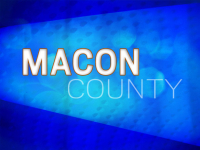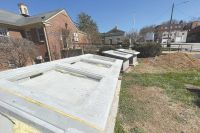Compromise forged to save metal truss bridge
 Macon County residents hoping to save an old metal truss bridge spanning the Little Tennessee River scored a small win, but the victory is bittersweet.
Macon County residents hoping to save an old metal truss bridge spanning the Little Tennessee River scored a small win, but the victory is bittersweet.
Battle to save historic truss bridge likely to end in compromise
A compromise has emerged in a fight over the historic McCoy truss bridge, one that would keep the old bridge in place for foot traffic while building a newer, bigger bridge alongside it for vehicles. But Macon residents who have spent nearly 10 years fighting for the bridge still feel ignored.
N.C. Department of Transportation workers and county commissioners cooked up the deal independently of the community’s wishes, according to resident Doug Woodward, who has labored for years to see McCoy Bridge renovated and saved for all types of vehicular traffic.
The debate over the truss bridge has become a symbol for a larger clash in the region between development and a rural way of life. Residents claim a sentimental attachment to the truss bridge, and fear a bigger, newer bridge will pave the way for more people and more traffic in their valley.
Commissioner Bobby Kuppers, who represents that area of Macon County, has said that he believes building a new bridge while saving McCoy Bridge is the best option available. Last May, the full five-member board of commissioners endorsed Kuppers’ proposal.
DOT officials are now indicating they’ll go along with the idea, including kicking in $126,000 toward renovating the truss structure. The DOT sent a letter to the county agreeing in concept. The money is contingent on Macon County assuming ownership of McCoy Bridge.
McCoy Bridge, which straddles the Little Tennessee River in the Oak Grove community, is one of a few truss bridges remaining in the state and the last in Macon County. DOT, which would have access to federal funds for much of the cost of a new bridge, wants to replace the one-lane crossing with a new one.
The DOT has cited safety as a factor. Engineers have deemed McCoy Bridge “functionally obsolete” and unable to handle future traffic demands. Its structural integrity is suspect, they say.
They’ve argued for a safe and historic working bridge: Not two bridges — one for motorists and the other for pedestrians and bike users — but a single, working bridge for everyone.
Woodward said the commissioners’ compromise had been considered, but discarded, as an option early on. Residents even submitted an engineering redesign of their own during a meeting with state transportation officials a few years ago.
Woodward said that the redesign was a workable compromise and that it would bring McCoy up to modern load-bearing standards, yet retain most of the historical character of the bridge.
Ralph Kennedy of the state Department of Transportation said will buy necessary right-of-way for the new bridge in 2014 with an estimated cost of $410,000. Construction is slated to begin in 2016, with a cost of about $2.5 million, he said.
McCoy bridge compromise muddies debate
A proposed compromise by Macon County commissioners on a historic bridge outside of Franklin isn’t sitting well with those who’ve fought for nearly a decade to save it.
Last week, the county board voted unanimously to ask the N.C. Department of Transportation to spare McCoy Bridge, one of the few truss bridges remaining in the state, which straddles the Little Tennessee River in the Oak Grove community. The state wants to replace the one-lane bridge with a new one — which would allow two vehicles to pass and hold more weight — for safety reasons. Residents who view the old bridge as emblematic of the community’s rural character have been locked in a decade-long battle with transportation officials over its fate.
Trying to broker a compromise, Macon commissioners suggested building the new bridge, and transforming the truss bridge into a pedestrian/bike-only bridge. This saves the cost of tearing down, which then could be applied to improvements. Rose Creek resident and Commissioner Bobby Kuppers, who could not be reached for comment, crafted the compromise resolution.
“There’s undeniably a need for safe passage there, for ambulances and school buses,” Commission Chairman Brian McClellan said, describing the resolution as “a useful and reasonable compromise that satisfies everybody.”
Well, not exactly: “We’re deeply disappointed,” said Doug Woodward this week, a leading proponent to save McCoy Bridge, explaining most involved in the preservation battle are asking for a safe and historic working bridge. Not two bridges — one for motorists and the other for pedestrians and bike users — but a single, working bridge for everyone.
Woodward said the commissioners’ proposal had been considered, but discarded, as an option early on, with an engineering redesign submitted during a meeting with state transportation officials two years ago.
“That redesign was a workable compromise, would bring McCoy up to modern load-bearing standards, yet retain most of the historical character of the bridge — something many other Eastern states have made a priority,” he said.
Julia Merchant, spokesperson for the transportation department, said the commissioners’ resolution will result in the agency “taking another look to see if the existing McCoy Bridge can remain in place as a light-duty bicycle and pedestrian bridge that may better fit into the community vision for this area.
“The department is also reviewing options for providing a new bridge that meets current standards for cars, trucks and emergency vehicles. This means we are looking at what sorts of additional studies need to be done, what coordination efforts will have to take place and where the funding will come from.”
The review will get under way after May 25, when the deadline closes for comments on the project.
Merchant said the current project schedule called for right-of-way acquisition to begin in 2013, with construction scheduled to start in 2015. Because of the new studies, “that schedule is subject to change,” she said. “It is not known at this time what a revised schedule may look like.”
Woodward said he’s not sure what bridge preservers will, or can, do next — he’s hanging some hope on a letter sent in late April to Gov. Beverly Perdue outlining the community’s desires to save McCoy bridge.
Recession makes McCoy Bridge rehab an even better idea
Governments at all levels and all across the nation are broke. At every county courthouse and state house, money taken in from taxes and fees can’t match the spending elected officials have become accustomed to. As they say in literature, a reckoning is coming. Over the next several years, the relationship between taxpayers and our government will undergo a fundamental shift.
It’s a pendulum swing, similar to what we experienced with Ronald Reagan in the 1980s. Many of us won’t like the consequences, and so we’ll write opinion pieces or letters to the editor, or blog, or protest in the streets, and finally elect folks who will do our bidding. That’s the way it works.
As I was reading about local unrest toward government spending, I got an email form Doug Woodward about the McCoy Bridge in Macon County. You can see his thoughts in our letters section.
Woodward and his neighbors are up in arms about a bridge. I wrote about that bridge controversy nine years ago, and at that time my argument did not focus on the monetary cost of rehabilitating a bridge versus building a new one. Everyone had money back then, and building around the mountains was booming. No, I worried about the cultural and symbolic value of the old bridge to the community it served.
Today we can include the fiscal argument. If it is cheaper to rehab the old bridge and give the community what it wants, then just do it. It makes sense on every level.
Anyway, here’s a portion of that column from 2002 that Woodward asked us to re-print prior to the April 25 public hearing that could decide the fate of the bridge:
Bridges have a unique symbolism in literature and in real life. At their best they provide a thread of connectedness, while at other times they highlight the distance and depth of opposing views.
In Macon County, the McCoy Bridge crossing the Little Tennessee River just off N.C. 28 is bearing the burden of exposing how government and communities can sometimes work against each other. In this case, the individual entities involved don’t harbor ill will toward the other. The real underlying problem is that the government units — the county and the state — don’t have the kind of planning in place to adequately deal with the situation that has arisen.
When that occurs, the government entities and the private citizens must share in the blame. Whether you believe it or not, in this country private citizens still determine what kind of government leaders they will have, and therefore share in whatever decisions are made. As we learn to grapple with the modern challenges of growth, sprawl and protecting the environment, this little bridge may provide an example of how to work together to meet common goals.
The McCoy Bridge is a one-lane vehicular truss bridge, the last one in Macon County. Vehicles traveling in opposite directions between the highway and Rose Creek Road must wait for cars coming across the bridge before they can pass. There is no room for zooming, two-way traffic moving at dangerous speeds. Residents in the Oak Grove community of northern Macon County want it to remain that way.
… The bridge serves a rural community a few miles outside of Franklin. As it is, massive, sprawling development on the opposite side of the river — and across the bridge — would be difficult. Many of those who might see the development potential of that mountain real estate would refrain because access is limited by the bridge. It serves as a kind of barrier, not natural, of course, but one that was built in 1939.
The state Department of Transportation, however, has determined that the bridge needs work. Engineers have deemed it functionally obsolete and unable to handle future traffic demands. Its structural integrity is suspect, they say.
…. There is also a very significant cultural and historical side to this issue. Throughout these mountains we are building roads and opening up rural areas for development instead of tackling the more difficult issue of protecting these lands and containing development in areas where infrastructure already exists. The DOT is right that the bridge is probably in dire need of some engineering work. A Ford Excursion certainly puts more stress on an old bridge than a 1945 Dodge did.
The trouble is that the DOT mandate to keep roads and bridges safe also enables them to carry more traffic, makes them wider, and makes them safer for higher speeds. Those attributes, though, are not necessarily good things for the community that uses the road — or the bridge in this case — that is being “improved.” And what we must remember is that the bridge was built to serve the community.
It’s easy to guess what will happen in this unique area of Macon County in the future if local and state leaders — along with private citizens — don’t wrestle with issues like this and get on the same page. Roads will be widened and curves will be straightened. Houses will be built. Schools will be needed in the outlying areas, solid waste will have to hauled somewhere, septic tanks or sewer lines, along with other infrastructure, will need to be built. Taxes will go up to meet these needs. The rural countryside five miles outside of Franklin will become just another suburb. A one-lane truss bridge will not be able to handle the traffic.
The McCoy Bridge dilemma serves as an example of the challenges facing these mountains. Residents who value our rural countryside have to make sure they put the leaders in place who have the same values, not those who will pave over paradise instead of working for a better alternative. Time is running out.
That warning from 2002 didn’t foresee the housing bubble burst and the ensuing recession. The dizzying pace of construction in the mountains has ground to a halt. So now we do have time to take stock of what’s important and work to save it. And we have to be more careful with every tax dollar that is spent.
In this case, we stand with the Woodward and the residents who live in this community — rehab the historic bridge and make it a showpiece instead of building a concrete slab spanning the Little Tennessee river.
(Scott McLeod can be reached at This email address is being protected from spambots. You need JavaScript enabled to view it.)
Public hearing
The N.C. Department of Transportation will hold a public hearing on Monday, April 25, regarding alternatives for replacing the McCoy Bridge. The hearing will take place from 6 to 8 p.m. at the Cowee Elementary School gymnasium. It will be a question-and-answer session with transportation officials. Maps displaying the bridge replacement alternatives will be available prior to the public hearing from 5 to 6 p.m.
Macon residents still waiting on McCoy Bridge plan
A year ago, state officials promised a group of Macon County residents that they would get a cost estimate for what it would take to rehabilitate the McCoy Bridge, a single lane truss bridge that dates from the 1930s.
That cost assessment hasn’t happened yet and now the North Carolina Department of Transportation says the project has dropped in priority because of the state’s budget crisis.
Residents want to save the McCoy Bridge because of its unique character and aesthetic value. The NCDOT, meanwhile, has argued that the bridge is not historic and needs to be replaced with a two-lane bridge with greater weight-bearing capacity. The bridge is seen by some as a symbol of the community’s rural character, something that could be comprised if a bigger bridge replaced it.
In response to opposition from residents to the NCDOT’s plan to replace the bridge, the agency promised it would provide a cost assessment for the bridge’s rehabilitation within the year, and a year is now up. Steve Abbot, communications director for the NCDOT, said that assessment hasn’t been completed and could not provide a concrete timetable for its completion.
The bottom line from the NCDOT’s perspective is that the state’s budget crisis and the I-40 rockslide have made the bridge a low priority.
“The project has been delayed due to the State’s financial crisis and other projects that are funded have been given higher priority for our resources,” Abbot said. “Until we work through the current issues, we will not be setting the project schedule.”
According to the DOT, the most current cost estimate for replacing the 290-foot bridge and its roadway approaches is $2.424 million, a figure that does not include any right-of-way acquisition or utility relocation cost.
Doug Woodward, a resident who has championed the McCoy Bridge cause, argues the bridge should be saved and that there is no good reason to put in new two-lane bridge on an access route that only carries about 300 vehicles per day.
School buses and emergency vehicles don’t use the bridge because the NCDOT has downgraded its weight-bearing capacity to three tons, roughly the weight of an SUV.
Pam Williams, the NCDOT’s engineer for the project, said the disagreement between her department and the residents boils down to a policy issue.
“DOT has a policy of not putting in one-lane bridges and they wanted us to look at the possibility of doing that,” Williams said.
Williams said the bridge has been up for historical designation three times and not been included on the register. Without a historic designation the bridge is not likely to be maintained in the state road system. As of 2009 there were only 36 truss bridges left on NCDOT-maintained roads.
“They do consider it an historic and iconic bridge and I understand that, but it is a truss bridge and truss bridges are considered fracture critical. In North Carolina we don’t build truss bridges anymore,” Williams said.
Abbot said that in the case of bridges with strong sentimental value, the NCDOT often uses its bridge relocation and reuse program to move the bridge to a place where it can be maintained and utilized by private or public entities for non-highway uses.
McCoy Bridge came into the NCDOT system in 1960 but it is believed to have been built in the late 1920s or early 1930s, according to Woodward. It is an example of a Pratt Through Truss Bridge, a common technology for early steel span bridges.
Woodward understands that the NCDOT doesn’t want a single span truss bridge in its system, but he pointed out that many states have found ways to preserve and utilize truss bridges. Iowa has over 1,400 truss bridges in operation, Woodward said.
To Woodward, the issue comes down to logic. The bridge is beautiful and it serves a small community with little potential for traffic increases. Why get rid of a nice bridge with historic value when a new bridge isn’t needed?
“If it can’t be rehabilitated adequately there are other ways to bring it up to a load-bearing standard that is not limiting school buses or emergency vehicles,” Woodward said. “The DOT would put a $4.6 million bridge in that location with 80 percent federal funding which would essentially be a concrete slab.”









